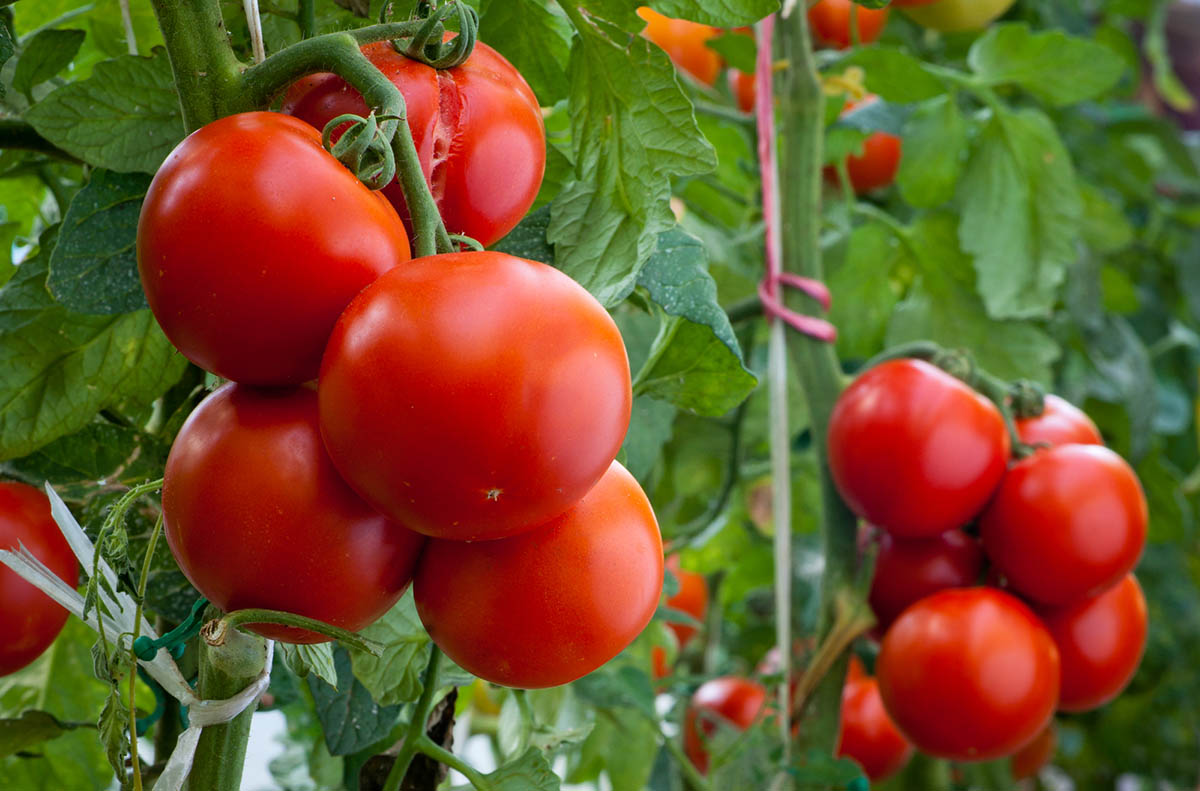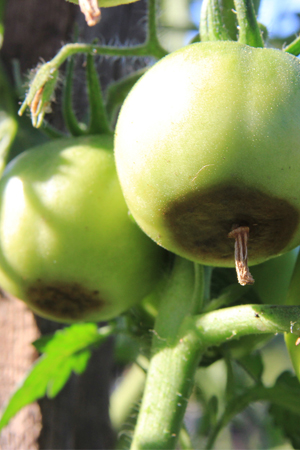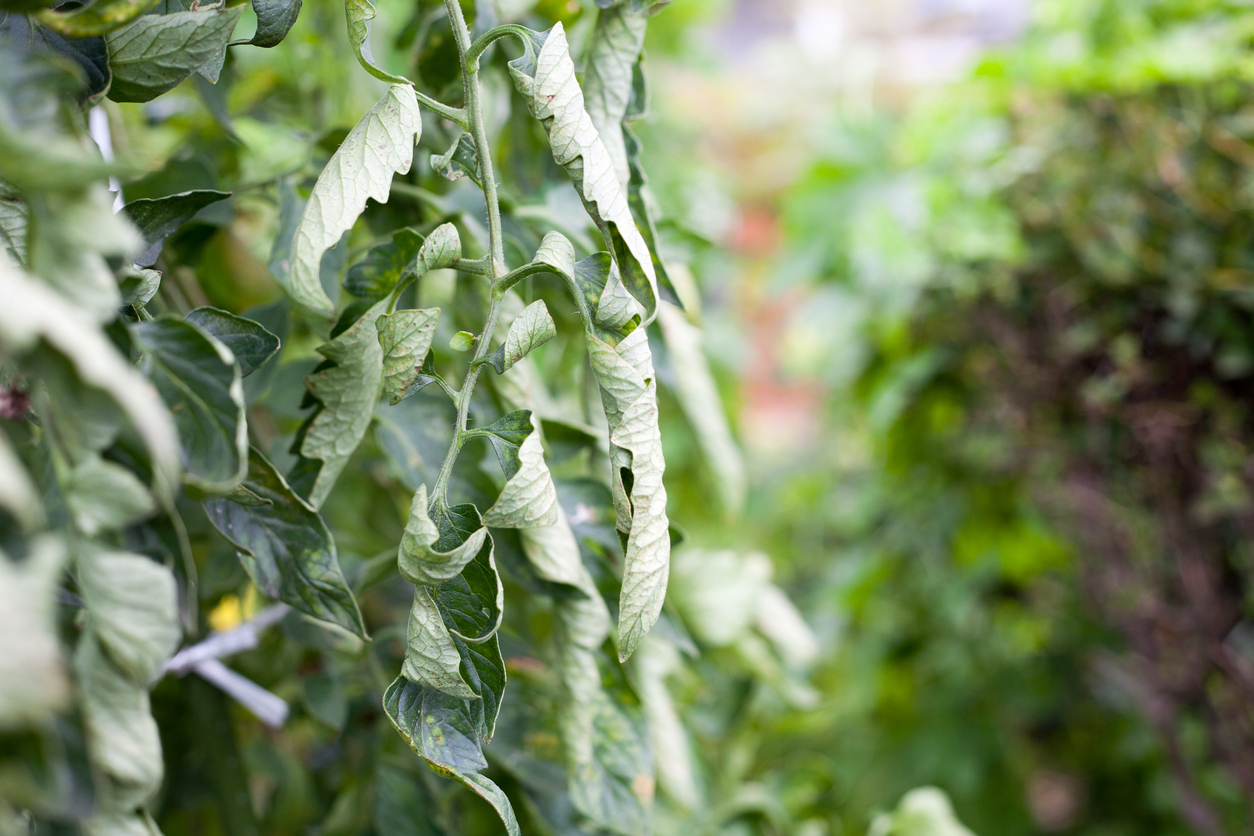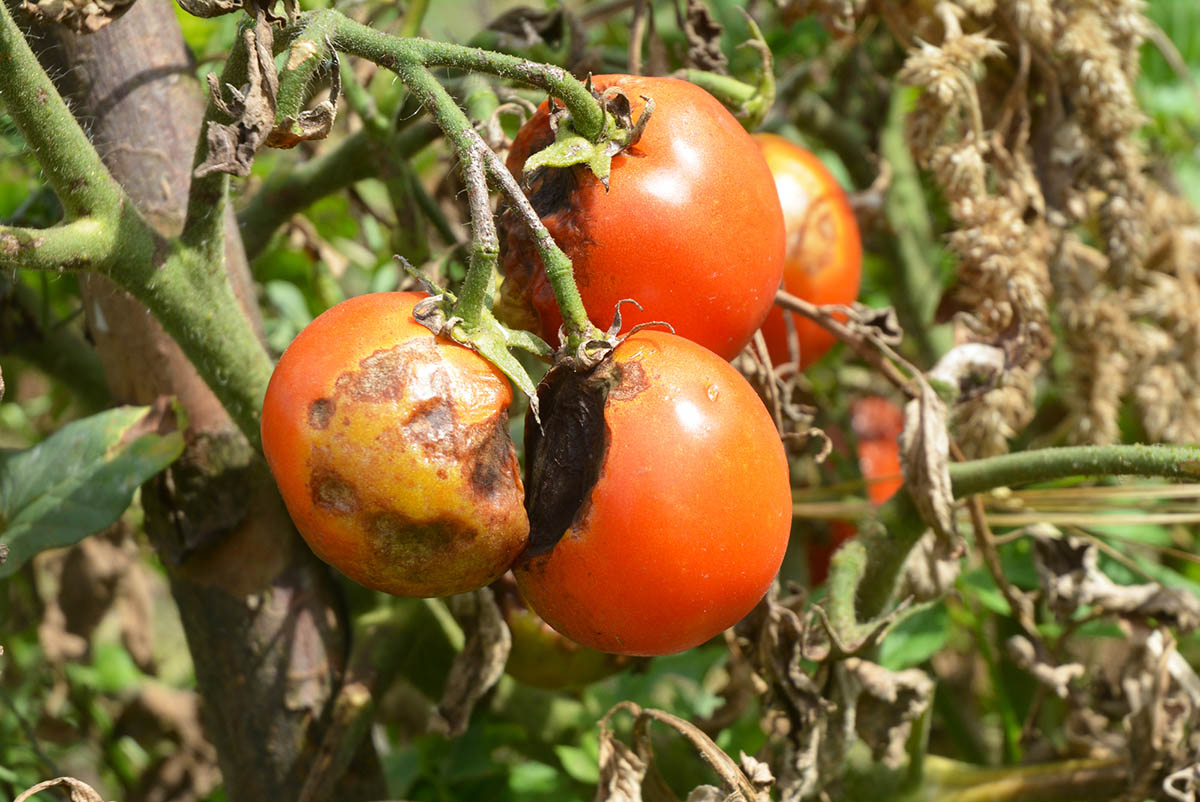

We may earn revenue from the products available on this page and participate in affiliate programs. Learn More ›
I have grown a vegetable garden for the past four years, and I just can’t figure out tomatoes. I get spots on the tomatoes, spots on the leaves, curling leaves, and occasionally an awesome tomato! What is causing my tomato plant problems?
A: Tomatoes are the most popular—and the most frustrating—backyard garden crop. When they have proper growing conditions, tomato plants provide a bountiful crop of the most sublime fruits. But when growing conditions are out of the ideal range, the plants become susceptible to diseases and insects, blossoms falling off instead of setting fruit, and problems with fruit quality.
Tomato plants grow best in full sun, in moist, well-draining, and slightly acidic soil. They need warm days and mild nighttime temperatures. They benefit from generous amounts of compost and a protective layer of mulch, but sometimes they still struggle. Continue reading to learn about 11 tomato plant problems and how to prevent them.

Blossom end rot might suggest a lack of calcium.
A common tomato plant problem is blossom end rot, the Michigan State University Extension offices reports. The plant might look healthy, flower normally, and begin to develop tomatoes. Suddenly, especially in hot weather, single round black patches appear on the very bottom of young green tomatoes, from where the flower blossoms have detached.
Blossom end rot ultimately occurs from a lack of available calcium, but the solution is not as simple as adding lime or some other supplement. The key word here is available. It is rare that soil actually lacks calcium. The real culprit almost always turns out to be a lack of soil moisture for plants to metabolize the nutrients that are present in the soil.
To prevent blossom end rot, use a rain gauge to monitor how much water your garden is getting. The combined rainfall and irrigation to your garden should equal an inch or slightly more per week. Container plants dry out more quickly and need more frequent watering than in-ground tomato plants. To confirm that your plants are receiving adequate moisture, stick your finger into the soil about 3 inches deep—it should feel moist, like wet laundry before you put it in the dryer.
Blossom drop comes from temperature fluctuations.
Another frustrating tomato plant problem is blossom drop. Again, the plant appears and flowers normally, but the flowers drop off without making tomatoes. Several factors contribute to blossom drop and poor fruit-set.
First, rule out excessively hot or cool temperatures. Tomato plants set fruit when daytime temperatures hover between 70 and 85 degrees Fahrenheit during the day, and between 55 and 70 degrees Farhenheit for the overnight low. Hot days, warm overnight temperatures, or cool temperatures outside of the ideal range can lead to blossom drop.
Similarly, tomato plants have a sweet spot for humidity. Between 40 and 70 percent relative humidity is best for tomato fruit-set. Outside that range, blossom drop becomes more prevalent. Gardeners can’t do much when the weather is working against them but wait for conditions to improve.
According to the Texas A&M AgriLife Extension County Offices, other contributors to blossom drop include lack of pollination, excess nitrogen in the soil, drought, insect damage, and heavy fruit-set. Prevent blossom drop by planting tomato varieties that are suitable for your climate, avoiding over-fertilizing with nitrogen, watering consistently, and protecting the plants from bug damage.
RELATED: The Best Fertilizers for Tomatoes

Hot and rainy weather causes fruit cracks.
Tomatoes grow best under consistent conditions. When summer storms rain down extra moisture into the soil, developing tomatoes expand rapidly from the inside. Unfortunately, the outer skin cannot grow quickly enough, and so it cracks and splits.
Cracks might appear as concentric rings at the top of the fruit or as deep radial (top to bottom) cracks. Harvest cracked tomatoes immediately. If they are partially ripe, they will finish ripening indoors. Dispose of any cracked tomatoes that smell sour or have oozing wounds. Avoid cracked tomatoes by planting crack-resistant varieties, providing consistent soil moisture, and mulching with plastic.
Watering the leaves directly can lead to leaf mold.
Tomato leaf mold is a fungal disease that affects tomato plants during high humidity and moderate temperatures. It begins on older foliage that exhibits pale greenish-yellow spots on the upper leaf surface and green-brown velvety mold on the lower surface. Leaf spots grow together before the leaves turn yellow and die, but remain attached to the plant. Infected fruits develop smooth dark patches on top that eventually shrink and turn leathery.
In a garden setting, overhead watering and crowded plants can create a microclimate that is ideal for growing and spreading this disease. Plant tomato leaf mold-resistant varieties. Prevent tomato leaf mold by spacing out plants and pruning suckers to allow good airflow. Always avoid wetting the foliage when watering tomato plants. Treat infected plants with a fungicide labeled for tomato leaf mold.

High temperatures and drought start a leaf roll.
In hot weather, or during drought, the leaves on tomato plants can begin to roll up. Tomato leaf roll is not a disease in the normal sense, but a physiological reaction to stress. It is more prevalent in vining tomato plants than bush types. Numerous types of stress can cause leaf roll to occur.
Environmental stresses like excessive moisture, nitrogen, heat, drought, severe pruning, root damage, and transplant shock are some of the factors that can cause leaf rolling. The lower leaves cup and then roll inward lengthwise toward the midvein. Affected leaves retain their normal color, but might thicken and become leathery. This can affect all of the foliage on the plant, but fruit production is undiminished.
Prevent tomato leaf rolling with good growing practices. Harden off tomato seedlings before planting them in the garden. Maintain consistent soil moisture. Avoid excessive fertilization and pruning.
Too much direct sunlight leads to sunscald.
Tomatoes are sun-loving plants, and it takes lots of sunshine to ripen tomatoes. But, too much of a good thing is not good. Sunscald appears as pale yellow or white blotches on the tomato where the sun shines intensely on it during the hottest part of the day. It normally results from pruning away foliage that had been protecting developing tomatoes. The sudden change to the tomato is like someone who works in an office and then goes to the beach without sunscreen.
Avoid sunscald by keeping tomatoes shaded by their own foliage. Reduce the risk of foliar diseases that lead to leaf drop or pruning by planting disease-resistant varieties, mulching beneath the plants, and eliminating overhead watering.
Low temperatures cause catfacing.
The malformation of the blossom end of the tomato is called catfacing. It is caused by cool temperatures (below 58 degrees Fahrenheit) during fruit development or excessive nitrogen in the soil. It also can come from pollination problems or damage to the flower during or just after pollination. Cultivars that make large tomatoes are most susceptible to this condition.
Prevent catfacing by planting resistant tomato varieties. Plant them after overnight temperatures have become consistently warm, and avoid high-nitrogen fertilizer.
Improper soil nutrition increases puffiness.
Sometimes tomatoes appear normal from the outside but have little or no fruit gel or seeds inside. Excess nitrogen can contribute to this tomato plant problem, called tomato puffiness. It happens when fruits develop in either excessively hot or cool temperatures that interfere with normal seed formation. Wet weather, humidity, and cloudiness are secondary contributors to puffiness since these conditions interfere with insect pollination. Plant at the proper time and avoid excessive fertilization to prevent tomato puffiness.

Drought, poor soil nutrition, and heat cause viral diseases.
A virus is a particle smaller than a single cell that spreads in one of two ways. Insects like aphids, thrips, and leafhoppers can carry and transmit viruses as they probe and feed on plants. Viruses also can spread by mechanical means, like when infected sap from one plant contacts a wound on another plant. Once inside the plant, a virus multiplies and spreads quickly. Infected plants show a range of symptoms including discoloration, distorted growth, poor yield, and plant death.
Tomato plants are especially susceptible to infection when already stressed by poor growing conditions such as drought, poor soil, and excessive heat. Reduce the chance of your tomatoes becoming infected by planting resistant varieties and maintaining consistent soil moisture. Tomatoes grow best in fertile, well-draining soil and full sunlight. Immediately remove and destroy a plant if it becomes infected to avoid infecting others.
Ensure good air ventilation to avoid powdery mildew.
Powdery mildew is a fungal disease that appears on tomato plants as a white powdery coating on the leaves. It thrives in high heat and humidity, especially in stagnant air and low light. Avoid powdery mildew by promoting good air circulation around the plants. Plant tomatoes at least 3 feet from one another. Prune away suckers that form in the leaf axils. Stake the plants, and keep the tomato patch weeded. Treat any infected plants with a fungicide labeled for powdery mildew on tomatoes.

Not enough space between plants might cause poor fruit-set.
Poor fruit-set on tomato plants can occur because of tight spacing. Sun-loving tomato plants need direct sunlight to produce plentiful flowers and fruit. If gardeners plant them too closely together, the plants soon will shade one another, and production will decline. Other problems with poor spacing include fungal and viral disease infection, insect infestation, and an impenetrable jungle of foliage that is difficult to maintain.
Allow plenty of space between plants for best sunlight exposure and air circulation, highest production, and ease of maintenance. Plant tomatoes at least 3 feet apart within rows. Space the rows 5 feet apart.
